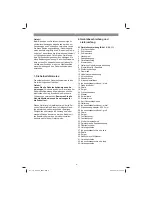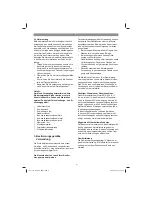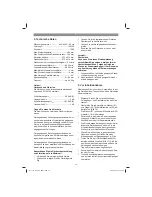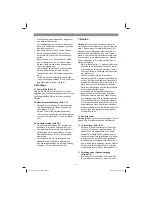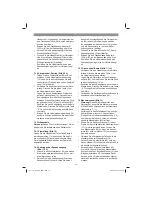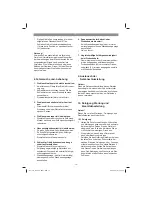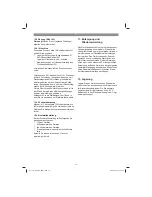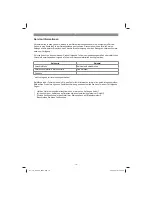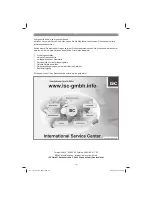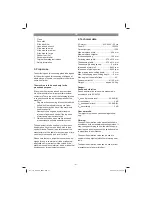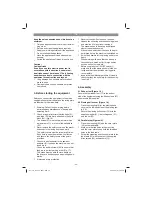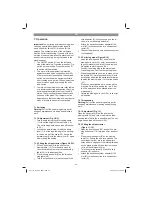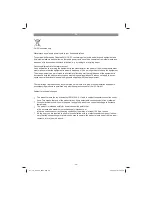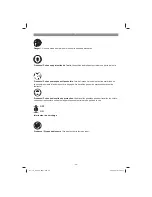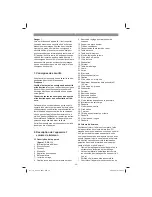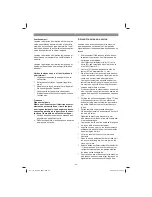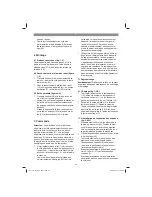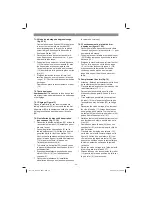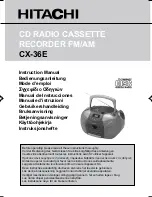
GB
- 22 -
Keep the noise emissions and vibrations to a
minimum.
•
Only use appliances which are in perfect wor-
king order.
•
Service and clean the appliance regularly.
•
Adapt your working style to suit the appliance.
•
Do not overload the appliance.
•
Have the appliance serviced whenever ne-
cessary.
•
Switch the appliance off when it is not in use.
Caution!
Residual risks
Even if you use this electric power tool in
accordance with instructions, certain resi-
dual risks cannot be rules out. The following
hazards may arise in connection with the
equipment’s construction and layout:
1. Lung damage if no suitable protective dust
mask is used.
2. Damage to hearing if no suitable ear protec-
tion is used.
5. Before starting the equipment
Before you connect the equipment to the mains
supply make sure that the data on the rating plate
are identical to the mains data.
•
Warning! Pull out the power plug before
performing any maintenance, cleaning and
adjusting work.
•
Check at regular intervals that the knife (21)
and latch (22) are firmly attached in the knife
block (23). (Fig. 16)
•
The knives (21) must not project more than
a maximum of 1.1 mm out of the knife block
(23).
•
Never remove the safety covers on the machi-
ne except for servicing and repair work.
•
The safety covers must be intact at all times.
Each time you use the machine, first fasten
and secure the safety covers at the points
provided.
•
Connect a dust extractor to the sawdust
extractor (5) if you use the machine in an enc-
losed area.
•
Check the anti-kick claws (24) to ensure that
they are in perfect working order (Fig. 17).
The claws must be able to move easily so
that they are freely suspended pointing down-
wards.
•
Always wear eye protection.
•
Never cut concavities, tenons or shapes.
•
Unpack the surfacing and thicknessing plane
and examine it for any transit damage.
•
The machine has to be set up and aligned
where it can stand securely.
•
All covers and safety devices have to be pro-
perly fitted before the machine is switched on.
•
It must be possible for the planing knife to run
freely.
•
When working with wood that has been pro-
cessed before, watch out for foreign bodies
such as nails or screws, etc.
•
Before you press the ON/OFF switch (1),
make sure that the planing knife is fitted cor-
rectly and that the machine’s moving parts
run smoothly.
•
Inspect the feed/discharge rollers (f) visually
check that they run uniformly for thicknessing.
(see Fig. 8).
6. Assembly
6.1 Rubber feet (Figure 1-2)
Secure the four rubber feet (11) to the bottom
side of the equipment using the Allen screws (37)
and washers (36) supplied.
6.2 Planing knife cover (Figure 1-3)
•
Place the mounting (8) for the planing knife
cover on the left-hand side of the planing tab-
le (14).
•
Secure the planing knife cover (12) with the
supplied washer (41), the locking knob (31)
and the nut (33).
6.3 Parallel stop (Figure 4/5)
•
Place the mounting (25) and the cover plate
(40) on the feed table.
•
Make sure that the holes in the mounting
and the cover plate line up with the threaded
holes in the feed table.
•
Screw the mounting and the cover plate to the
feed table (13) with the help of the supplied
Allen screws (42) and washers (13).
Anl_TC_SP_204_SPK7.indb 22
Anl_TC_SP_204_SPK7.indb 22
26.09.2016 11:45:16
26.09.2016 11:45:16

